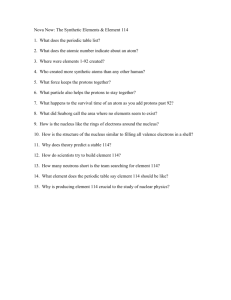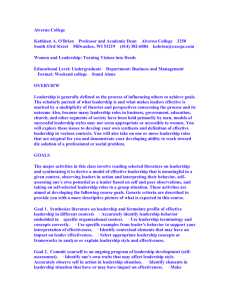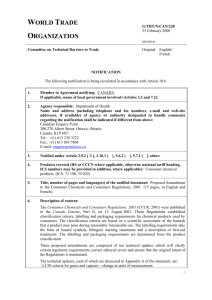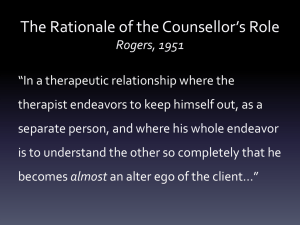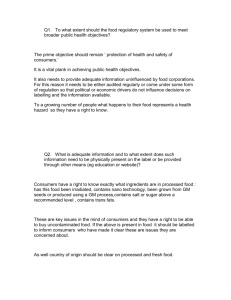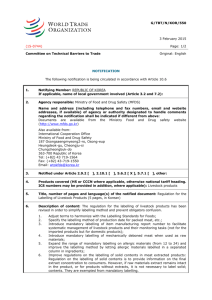Bio
advertisement
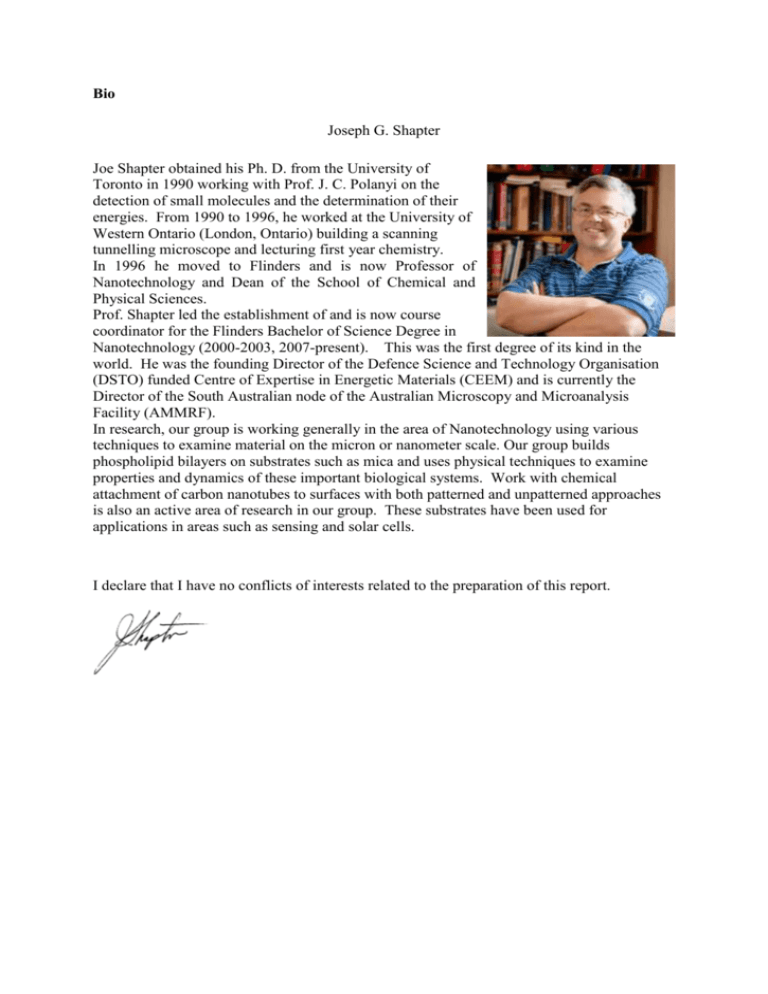
Bio Joseph G. Shapter Joe Shapter obtained his Ph. D. from the University of Toronto in 1990 working with Prof. J. C. Polanyi on the detection of small molecules and the determination of their energies. From 1990 to 1996, he worked at the University of Western Ontario (London, Ontario) building a scanning tunnelling microscope and lecturing first year chemistry. In 1996 he moved to Flinders and is now Professor of Nanotechnology and Dean of the School of Chemical and Physical Sciences. Prof. Shapter led the establishment of and is now course coordinator for the Flinders Bachelor of Science Degree in Nanotechnology (2000-2003, 2007-present). This was the first degree of its kind in the world. He was the founding Director of the Defence Science and Technology Organisation (DSTO) funded Centre of Expertise in Energetic Materials (CEEM) and is currently the Director of the South Australian node of the Australian Microscopy and Microanalysis Facility (AMMRF). In research, our group is working generally in the area of Nanotechnology using various techniques to examine material on the micron or nanometer scale. Our group builds phospholipid bilayers on substrates such as mica and uses physical techniques to examine properties and dynamics of these important biological systems. Work with chemical attachment of carbon nanotubes to surfaces with both patterned and unpatterned approaches is also an active area of research in our group. These substrates have been used for applications in areas such as sensing and solar cells. I declare that I have no conflicts of interests related to the preparation of this report. Cosmetics Module Factual correctness, Looks fine. Descriptions of the effects of some of the ancient treatments and the chemical therein might help the discussion Whether the descriptions of health and environment risks reflects accurately the current state of the science, Yes—it is worth pointing out that all the risks are not currently understood nor are the benefits. However, understanding both is hard because one nanoparticle is not the same as another nanoparticle even in fact if they were made of the same material. The recent sunscreen work by CSIRO could be included. Whether existing regulatory gaps are identified accurately, including where existing regulatory triggers or labelling requirements may not differentiate between bulk and nanoforms of a substance, and, Definitely-I don’t know if it is still true but it used to be the case that the cosmetic industry was the one industry that did not have labelling requirements. Curriculum relevance. Some very good activiites. I did not understand the connection to pH but am probably missing something. The connection for girls will be very good and the sunscreen stuff will be good for everyone. Side comment: Could we point out that nothing is “Chemical free”. This is a misconception many people have and of course pure water is not chemical free. The right question to be pushing people to discuss is what chemicals are in there and not whether or not there are any chemicals. Space Elevator Factual correctness The facts are correct and the description of how the space elevator would work are very good. The toilet story is great and students would like it. Whether the descriptions of health and environment risks reflects accurately the current state of the science, Probably not in this case. There has been significant work on the toxicity of nanotubes much of it conflicting but it is worth highlighting. Perhaps the best way to start of the conversation is simply about the shape of the nanotubes and how the body or cells might or might not be able to handle such things. Additionally, it is important to point out some of the things that effect risk—the worker in the nanotube factory is at a much great risk than the person who might someday ride the elevator. Whether existing regulatory gaps are identified accurately, including where existing regulatory triggers or labelling requirements may not differentiate between bulk and nanoforms of a substance, and, I don’t think there is any mention of this in this module but I also don’t think any gaps exist so that is fine in my view. Labelling requirements are continually being modified for nano and other reasons and such labelling will handle the materials as needed. Curriculum relevance. Not so obvious to me. Core to the space elevator are material properties and I am not sure this is done much in schools. Certainly in lower years they talk about magnetic things and things that conduct etc. but I am not sure how much work is done re one material being stronger than the other? Additionally, is a space elevator really relevant to most people— would simply making car panel much stronger yet lighter be just as much of a hook? A side comment: A good activity might be to get the students to build the tallest tower they can say out of logo blocks—it will sway lots and might help highlight why the strength and flexibility of the nanotubes are so important in this application. Magazine Insert Factual correctness The highlighting of the top Australian efforts is great. All the facts are correct. Whether the descriptions of health and environment risks reflects accurately the current state of the science, The fact that there are risks is highlighted. I think is always worth pointing out that with anything new there are risk and benefits—we as society and as individuals have to weigh these up in making decisions just as we did in deciding to use a mobile phone when people were suggesting brain cancers might be possible due to their use. This assessment of risk is not unique to nanotech—having information to make intelligent decisions is most important and difficult in nanotech due to the range of materials under discussions. Whether existing regulatory gaps are identified accurately, including where existing regulatory triggers or labelling requirements may not differentiate between bulk and nanoforms of a substance, and, Definitely—appears in many activities and in the piece about Amanda. Curriculum relevance. Really good. The energy and water parts will be very relevant while the activities fit very nicely. Some stronger connection the core enabling sciences like the questions re hydrophobicity in the magic sand activity might strength the relevance but that is a very minor comment.
